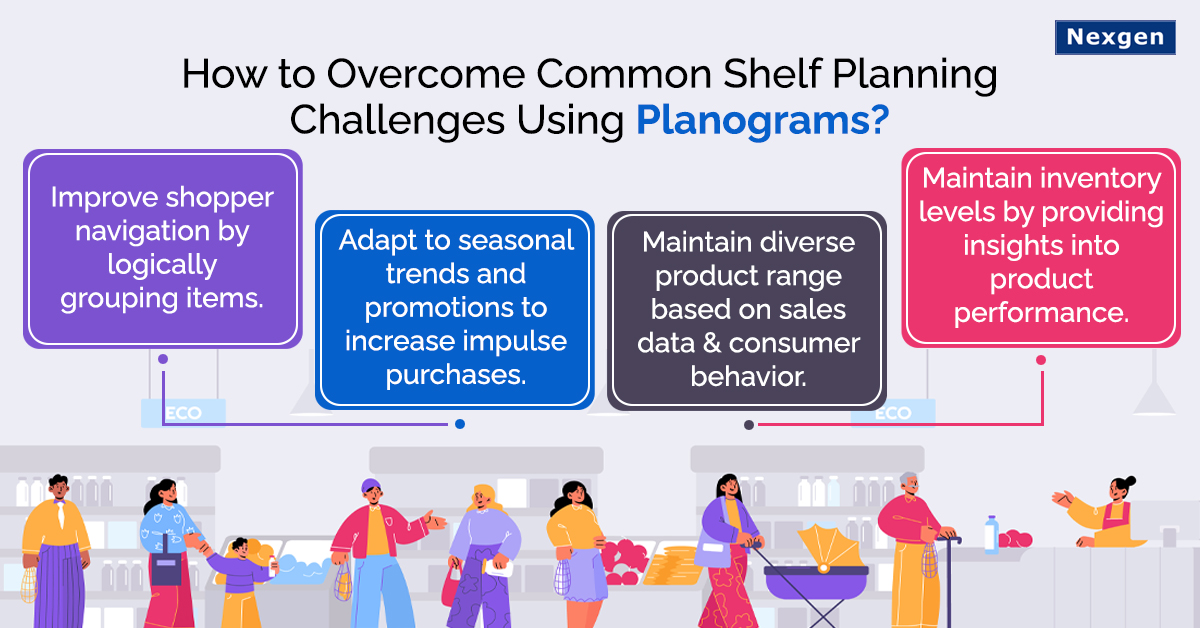Shelf planning is a critical aspect of retail merchandising, ensuring products are strategically positioned to maximize sales and enhance the shopping experience. However, it is not without its challenges. From limited space to ensuring product visibility and managing inventory efficiently, retailers often face hurdles in optimizing their shelves. Planograms offer a solution to these common challenges, empowering retailers to overcome shelf planning obstacles to drive sales. In this blog, we will explore how planograms can help retailers reduce shelf planning challenges.
Understanding Shelf Planning Challenges
Before delving into solutions, it is essential to grasp the common obstacles faced in shelf planning:
- Limited space: Retailers must make the most of their shelf real estate, especially in stores with confined spaces.
- Product visibility: Ensuring products are visible to customers is crucial to driving sales. Poor visibility can lead to missed opportunities and decreased revenue.
- Inventory management: Efficiently managing inventory levels to prevent overstocking or stockouts is a perpetual challenge for retailers.
- Seasonal changes: Retailers often need to adapt their shelves to accommodate seasonal products or changing consumer preferences.
Overcoming Challenges with Planograms
Planograms offer a systematic approach to shelf planning, addressing these challenges effectively. Here is how:

- Space optimization: Planograms allow retailers to visualize and plan the placement of products to maximize space utilization. By arranging products based on their dimensions and sales performance, retailers can make informed decisions to optimize shelf space. For example, apparel stores can utilize double-sided clothing racks positioned strategically throughout the store to maximize space efficiency. Retailers can arrange clothing racks by category (e.g., tops, bottoms, dresses) and subcategories (e.g., casual, formal, athleisure) for easy navigation.
- Enhancing product visibility: With planograms, retailers can strategically position high-demand or promotional items at eye level to enhance visibility. By organizing shelves based on consumer behavior and preferences, retailers can ensure products are easily spotted by shoppers, leading to increased sales. For example, creating vibrant front-end displays near the entrance of the grocery store can showcase high-demand and frequently purchased items, seasonal produce, cross-merchandising, or special promotions at eye level on shelves throughout the store. This helps to draw shopper’s attention and encourage impulse purchases.
- Streamlining inventory management: Planograms help retailers maintain optimal inventory levels by providing insights into product performance and sales trends. By regularly updating planograms to reflect changes in demand or seasonal variations, retailers can prevent overstocking and stockouts, improving inventory management efficiency. Retailers can designate specific areas within the store for clearance items and promotional displays. Adjusting inventory levels and product assortments based on planogram insights or reports can optimize inventory turnover and maximize profitability.
- Adapting to seasonal changes: Planograms facilitate quick adjustments to shelves to accommodate seasonal products or promotions. Retailers can create seasonal planograms in advance, ensuring smooth transitions between product offerings and maximizing sales opportunities during peak seasons.
Implementing planograms effectively:
To reap the full benefits of planograms, retailers must follow these best practices:
- Regularly update planograms based on sales data and customer feedback.
- Train staff on planogram implementation and maintenance procedures.
- Utilize technology-driven planogram software for efficient shelf planning and management.
- Collaborate with vendors and suppliers to align product placement with marketing strategies and promotions.
Overview of Nexgen POG
Nexgen POG is a robust and user-friendly cloud-based visual merchandising tool. It is designed for quick and efficient planogramming with minimal effort. Planogram in retail can be designed by easily dragging and dropping the products. The multi-device compatibility feature of POG allows you to obtain, share and edit planogram on any device, including your phone. It helps in designing store-specific planograms for increased product visibility and sales.
Get Your Free Trial Now!